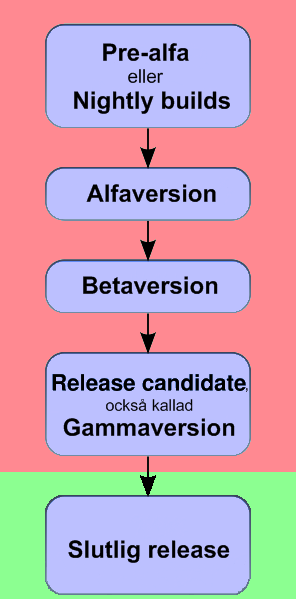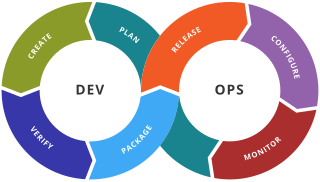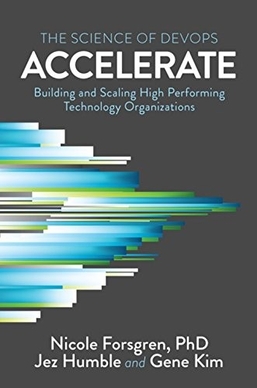Related Research Articles
Release engineering, frequently abbreviated as RE or as the clipped compound Releng, is a sub-discipline in software engineering concerned with the compilation, assembly, and delivery of source code into finished products or other software components. Associated with the software release life cycle, it was said by Boris Debic of Google Inc. that release engineering is to software engineering as manufacturing is to an industrial process:
Release engineering is the difference between manufacturing software in small teams or startups and manufacturing software in an industrial way that is repeatable, gives predictable results, and scales well. These industrial style practices not only contribute to the growth of a company but also are key factors in enabling growth.
AnthillPro is a software tool originally developed and released as one of the first continuous integration servers. AnthillPro automates the process of building code into software projects and testing it to verify that project quality has been maintained. Software developers are able to identify bugs and errors earlier by using AnthillPro to track, collate, and test changes in real time to a collectively maintained body of computer code.
API testing is a type of software testing that involves testing application programming interfaces (APIs) directly and as part of integration testing to determine if they meet expectations for functionality, reliability, performance, and security. Since APIs lack a GUI, API testing is performed at the message layer. API testing is now considered critical for automating testing because APIs now serve as the primary interface to application logic and because GUI tests are difficult to maintain with the short release cycles and frequent changes commonly used with Agile software development and DevOps.

Release management is the process of managing, planning, scheduling and controlling a software build through different stages and environments; it includes testing and deploying software releases.
Continuous testing is the process of executing automated tests as part of the software delivery pipeline to obtain immediate feedback on the business risks associated with a software release candidate. Continuous testing was originally proposed as a way of reducing waiting time for feedback to developers by introducing development environment-triggered tests as well as more traditional developer/tester-triggered tests.
Continuous delivery (CD) is a software engineering approach in which teams produce software in short cycles, ensuring that the software can be reliably released at any time and following a pipeline through a "production-like environment", without doing so manually. It aims at building, testing, and releasing software with greater speed and frequency. The approach helps reduce the cost, time, and risk of delivering changes by allowing for more incremental updates to applications in production. A straightforward and repeatable deployment process is important for continuous delivery.
Application-release automation (ARA) refers to the process of packaging and deploying an application or update of an application from development, across various environments, and ultimately to production. ARA solutions must combine the capabilities of deployment automation, environment management and modeling, and release coordination.

BuildMaster is an application release automation tool, designed by the software development team Inedo. It combines build management and ARA capabilities to manage and automate processes primarily related to continuous integration, database change scripts, and production deployments, overall releasing applications reliably. The tool is browser-based and able to be used "out-of-the-box". Its feature set and scope puts it in line with the DevOps movement, and is marketed as "more than a release automatigs together the people, processes, and practices that allow teams to deliver software rapidly, reliably, and responsibly.” It's a tool that embodies incremental DevOps adoption.
In software engineering, a microservice architecture is a variant of the service-oriented architecture structural style. It is an architectural pattern that arranges an application as a collection of loosely coupled, fine-grained services, communicating through lightweight protocols. One of its goals is that teams can develop and deploy their services independently of others. This is achieved by the reduction of several dependencies in the code base, allowing developers to evolve their services with limited restrictions from users, and for additional complexity to be hidden from users. As a consequence, organizations are able to develop software with fast growth and size, as well as use off-the-shelf services more easily. Communication requirements are reduced. These benefits come at a cost to maintaining the decoupling. Interfaces need to be designed carefully and treated as a public API. One technique that is used is having multiple interfaces on the same service, or multiple versions of the same service, so as to not disrupt existing users of the code.
XebiaLabs is an independent software company specializing in DevOps and continuous delivery for large enterprise organizations. XebiaLabs offers a DevOps Platform for application-release automation (ARO). These components include release orchestration, deployment automation and DevOps intelligence.
Perforce Software, Inc. is an American developer of software used for developing and running applications, including version control software, web-based repository management, developer collaboration, application lifecycle management, web application servers, debugging tools and agile planning software.
Infrastructure as code (IaC) is the process of managing and provisioning computer data center resources through machine-readable definition files, rather than physical hardware configuration or interactive configuration tools. The IT infrastructure managed by this process comprises both physical equipment, such as bare-metal servers, as well as virtual machines, and associated configuration resources. The definitions may be in a version control system, rather than maintaining the code through manual processes. The code in the definition files may use either scripts or declarative definitions, but IaC more often employs declarative approaches.

A DevOps toolchain is a set or combination of tools that aid in the delivery, development, and management of software applications throughout the systems development life cycle, as coordinated by an organisation that uses DevOps practices.
Continuous configuration automation (CCA) is the methodology or process of automating the deployment and configuration of settings and software for both physical and virtual data center equipment.
In software engineering, CI/CD or CICD is the combined practices of continuous integration (CI) and continuous delivery (CD) or, less often, continuous deployment. They are sometimes referred to collectively as continuous development or continuous software development.
DataOps is a set of practices, processes and technologies that combines an integrated and process-oriented perspective on data with automation and methods from agile software engineering to improve quality, speed, and collaboration and promote a culture of continuous improvement in the area of data analytics. While DataOps began as a set of best practices, it has now matured to become a new and independent approach to data analytics. DataOps applies to the entire data lifecycle from data preparation to reporting, and recognizes the interconnected nature of the data analytics team and information technology operations.
Nicole Forsgren is an American technology executive, IT impact expert, and author. In 2020 she was named vice-president of Research & Strategy at Microsoft's GitHub and more recently Partner at Microsoft Research. She is coauthor of Accelerate: The Science of Lean Software and DevOps which won the Shingo Research and Professional Publication Award in 2019.

Accelerate: The Science of Lean Software and DevOps: Building and Scaling High Performing Technology Organizations is a software engineering book co-authored by Nicole Forsgren, Jez Humble and Gene Kim. The book explores how software development teams using Lean Software and DevOps can measure their performance and the performance of software engineering teams impacts the overall performance of an organization.
TestOps refers to the discipline of managing the operational aspects of testing within the software delivery lifecycle.
Mobile DevOps is a set of practices that applies the principles of DevOps specifically to the development of mobile applications. Traditional DevOps focuses on streamlining the software development process in general, but mobile development has its own unique challenges that require a tailored approach. Mobile DevOps is not simply as a branch of DevOps specific to mobile app development, instead an extension and reinterpretation of the DevOps philosophy due to very specific requirements of the mobile world.
References
- ↑ Courtemanche, Meredith; Mell, Emily; Gills, Alexander S. "What Is DevOps? The Ultimate Guide". TechTarget. Retrieved 2023-01-22.
- ↑ Dyck, Andrej; Penners, Ralf; Lichter, Horst (2015-05-19). "Towards Definitions for Release Engineering and DevOps". 2015 IEEE/ACM 3rd International Workshop on Release Engineering. IEEE. p. 3. doi:10.1109/RELENG.2015.10. ISBN 978-1-4673-7070-7. S2CID 4659735.
- ↑ Jabbari, Ramtin; bin Ali, Nauman; Petersen, Kai; Tanveer, Binish (May 2016). "What is DevOps?: A Systematic Mapping Study on Definitions and Practices". Proceedings of the 2016 Scientific Workshop. Association for Computing Machinery.
- 1 2 Erich, F.M.A.; Amrit, C.; Daneva, M. (June 2017). "A Qualitative Study of DevOps Usage in Practice" (PDF). Journal of Software: Evolution and Process. 29 (6): e1885. doi:10.1002/smr.1885. S2CID 35914007.
- ↑ Bass, Len; Weber, Ingo; Zhu, Liming (2015). DevOps: A Software Architect's Perspective. Addison-Wesley. ISBN 978-0134049847.
- ↑ Muñoz, Mirna; Negrete Rodríguez, Mario (April 2021). "A guidance to implement or reinforce a DevOps approach in organizations: A case study".
{{cite journal}}: Cite journal requires|journal=(help) - ↑ Chapman, M., Gatti, N: A model of a service life cycle, Proceedings of TINA '93, pp. I-205–I-215, Sep., 1993.
- ↑ Atlassian. "History of DevOps". Atlassian. Retrieved 2023-02-23.
- ↑ Mezak, Steve (25 January 2018). "The Origins of DevOps: What's in a Name?". devops.com. Retrieved 6 May 2019.
- ↑ Debois, Patrick (9 October 2008). "Agile 2008 Toronto". Just Enough Documented Information. Retrieved 12 March 2015.
- ↑ Debois, Patrick. "DevOps Days". DevOps Days. Retrieved 31 March 2011.
- 1 2 Alana Brown; Nicole Forsgren; Jez Humble; Nigel Kersten; Gene Kim (2016). "2016 State of DevOps Report" (PDF). Puppet Labs, DORA (DevOps Research. Retrieved 2024-04-24.
- ↑ "Puppet - Alanna Brown". Puppet Labs. Retrieved 2019-04-27.
- ↑ Nicole Forsgren; Gene Kim; Nigel Kersten; Jez Humble (2014). "2014 State of DevOps Report" (PDF). Puppet Labs, IT Revolution Press and ThoughtWorks. Retrieved 2024-04-24.
- ↑ "2015 State of DevOps Report" (PDF). Puppet Labs, Pwc, IT Revolution Press. 2015. Retrieved 2024-04-24.
- ↑ "More Agile Testing" (PDF). October 2014. Retrieved 2019-05-06.
- ↑ Crispin, Lisa; Gregory, Janet (October 2014). More Agile Testing. Addison-Wesley. ISBN 9780133749571 . Retrieved 2019-05-06.
- ↑ Turner, Graham (20 November 2023). "Report: Software Engineers Face Backlash for Reporting Wrongdoing". DIGIT. Retrieved 5 January 2024.
- ↑ Saran, Cliff. "Software engineers worry about speaking out - Computer Weekly". ComputerWeekly.com. Retrieved 5 January 2024.
- ↑ "75% of software engineers faced retaliation the last time they reported wrongdoing - ETHRWorldSEA". ETHRWorld.com.
- ↑ Cummins, Holly. "Holly Cummins on X". X.com. Retrieved 5 January 2024.
- ↑ DeBellis, Derek; Lewis, Amanda; Villalba, Daniella; Farley, Dave. "2023 State of DevOps Report". Google Cloud DevOps Research and Assessment. Retrieved 2024-04-24.
- ↑ DeBellis, Derek; Harvey, Nathan. "2023 State of DevOps Report: Culture is everything". Google Cloud Blog. Retrieved 2024-04-24.
- ↑ Klein, Brandon Thorin (2021-05-01). "The DevOps: A Concise Understanding to the DevOps Philosophy and Science". Osti.gov. doi:10.2172/1785164. OSTI 1785164. S2CID 236606284.
- ↑ "The History and Evolution of DevOps | Tom Geraghty". 5 July 2020. Retrieved 2020-11-29.
- ↑ "Principles behind the Agile Manifesto". agilemanifesto.org. Retrieved 2020-12-06.
- ↑ Castellanos, Camilo; Correal, Dario (15 September 2018). "Executing Architectural Models for Big Data Analytics". Software Architecture. Lecture Notes in Computer Science. Vol. 11048. pp. 364–371. doi:10.1007/978-3-030-00761-4_24. ISBN 978-3-030-00760-7.
- ↑ Humble, Jez; Farley, David (2011). Continuous Delivery: reliable software releases through build, test, and deployment automation. Pearson Education Inc. ISBN 978-0-321-60191-9.
- ↑ Chen, Lianping (2015). "Continuous Delivery: Huge Benefits, but Challenges Too". IEEE Software. 32 (2): 50–54. doi:10.1109/MS.2015.27. S2CID 1241241.
- ↑ Tak, Rohin; Modi, Jhalak (2018). Mobile DevOps: Deliver continuous integration and deployment within your mobile applications. Packt Publishing. pp. 12–18. ISBN 9781788296243.
- ↑ Beyer, Betsy; Jones, Chris; Petoff, Jennifer; Murphy, Niall Richard (April 2016). Site Reliability Engineering. O'Reilly Media. ISBN 978-1-4919-2909-4.
- ↑ Analyzing the DNA of DevOps, Brent Aaron Reed, Willy Schaub, 2018-11-14.
- ↑ Gene Kim; Patrick Debois; John Willis; Jezz Humble (2016). The DevOps Handbook: How to Create World-Class Agility, Reliability, and Security in Technology Organizations.
- ↑ "OWASP TOP10". Archived from the original on June 8, 2023. Retrieved June 8, 2023.
- ↑ Wilson, Glenn (December 2020). 'DevSecOps: A leader's guide to producing secure software with compromising flow, feedback and continuous improvement'. Rethink Press. ISBN 978-1781335024.
- ↑ Emerging Technology Analysis: DevOps a Culture Shift, Not a Technology (Report). Gartner.
- ↑ Loukides, Mike (7 June 2012). "What is DevOps?". O'Reilly Media.
- ↑ "Gartner IT Glossary – devops". Gartner. Retrieved 30 October 2015.
- ↑ Jones, Stephen; Noppen, Joost; Lettice, Fiona (21 July 2016). Proceedings of the 2nd International Workshop on Quality-Aware DevOps - QUDOS 2016 (PDF). pp. 7–11. doi:10.1145/2945408.2945410. ISBN 9781450344111. S2CID 515140.
- ↑ Mandi Walls (25 September 2015). "Building a DevOps culture". O'Reilly.
- ↑ Chen, Lianping; Ali Babar, Muhammad (2014). "2014 IEEE/IFIP Conference on Software Architecture". The 11th Working IEEE/IFIP Conference on Software Architecture(WICSA 2014). IEEE. pp. 195–204. doi:10.1109/WICSA.2014.45. ISBN 978-1-4799-3412-6.
- ↑ Teja Yarlagadda, Ravi (9 March 2021). "DevOps and Its Practices". SSRN 3798877.
- ↑ Morisio, Maurizio (16 April 2021). DevOps: development of a toolchain in the banking domain. Politecnico di Torino (laurea thesis). Retrieved 16 August 2021.
- ↑ "What is GitOps?". www.redhat.com. Retrieved 2023-03-30.